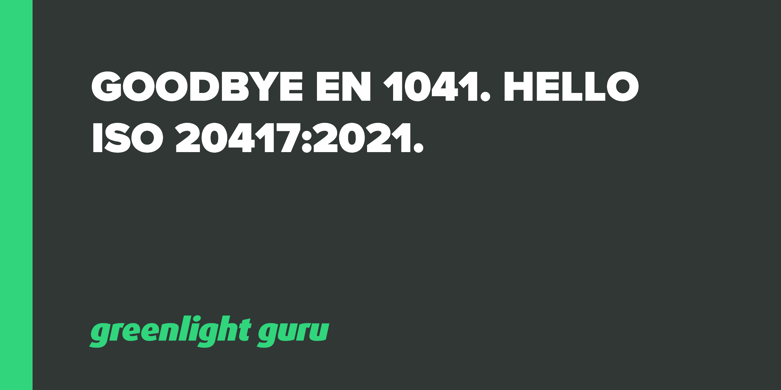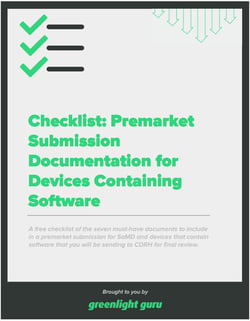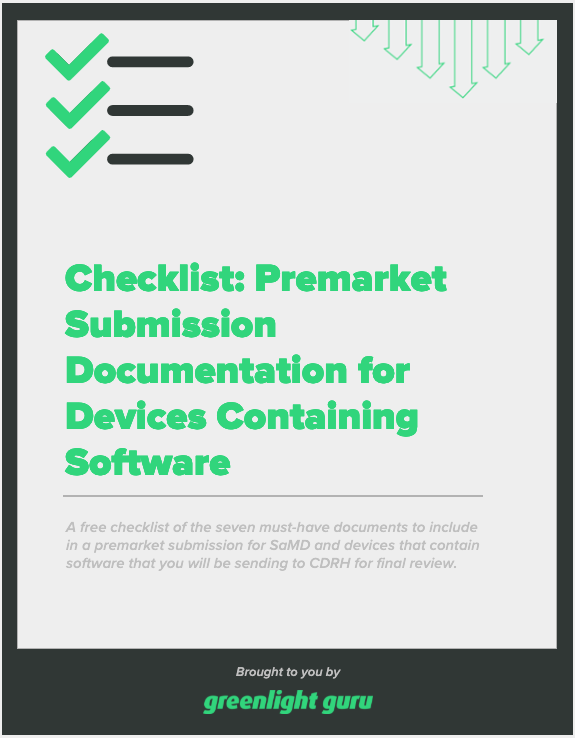ISO 20417:2021 Replaces EN 1041: What You Need To Know

Providing the proper accompanying information for your medical device is critical to its safe and effective use—which is why all accompanying information is also regulated by the same bodies that govern the design, development, and manufacture of the medical devices themselves.
And thankfully, there’s a new standard in town. It’s full name is ISO 20417:2021 Medical devices - Information to be supplied by the manufacturer, but I’ll simply refer to it as ISO 20417:2021 from here on.
ISO 20417:2021 is meant as a replacement for an older standard, EN 1041. The goal of the new standard is to create a source of generally applicable information requirements, as well as offer more clarity around information requirements in other, existing regulations.
Basically, ISO 20417:2021 is meant to be the master guide to the information manufacturers have to provide with their device.
So, let’s take a closer look at what ISO 20417:2021 does and how it differs from its predecessor, EN 1041.
What are EN 1041 and ISO 20417:2021?
ISO 20417:2021 and EN 1041 are both standards for the information medical device manufacturers are required to supply along with their devices. This information may encompass instructions for use, technical descriptions, packaging, and marking, as well as any accompanying documentation.
EN 1041 was created to help medical device companies comply with the requirements of the European Medical Device Directives (MDD). However, the MDD itself has been supplanted by the Medical Device Regulation (MDR), which is part of the reason a new information standard was necessary.
ISO 20417:2021 was created to update product information regulations and to be a generally applicable standard for all medical device manufacturers. That means ISO 20147:2021 was written to account for the requirements of several other related regulatory documents, including:
-
MDR (EU) 2017/745 - The European Union Medical Device Regulation
-
IVDR (EU) 2017/746 - EU In Vitro Diagnostic Regulation
-
IMDRF/GRRP WG/N47:2018 - Essential Principles of Safety and Performance of Medical Devices and IVD Medical Devices
-
IMDRF/GRRP WG/N52:2019 - Principles of Labelling for Medical Devices and IVD Medical Devices
ISO 20417:2021 clarifies many of the aforementioned requirements and offers guidance on how to comply with them, making it the go-to resource for medical device manufacturers who need to ensure the conformity of their accompanying information.
What are the differences between EN 1041 and ISO 20417:2021?
The most immediately noticeable difference between the two standards is their scope. ISO 20417:2021 is more than 80 pages long, and its structure is significantly different from that of EN 1041.
For one thing, the single section on requirements in EN 1041 has been split into two sections within ISO 20417:2021:
-
General considerations
-
Information elements to be established
This is partly due to the increased number of requirements in ISO 20417:2021. Other sections from EN 1041, such as “Legibility of the label” and “Durability of markings” have also increased in scope in the new ISO standard.
ISO 20417:2021 dedicates a significant portion of the standard to clarifying terms and requirements from regulations such as the MDR and IVDR. For example, ISO 20417:2021 does not use the word “labeling.” Rather, it uses the term “accompanying information.”
Though it may seem like a small change, this usage helps to clarify language that has been used in other regulations. For instance:
-
The MDR and IVDR both use the terms “label” and “labeling” interchangeably.
-
Other regulations, such as ISO 13845 and the International Medical Device Regulators Forum (IMDRF) use “labeling” and “accompanying information” synonymously.
For such a highly-regulated industry, this is a problem. Different definitions and usage among standards leads to confusion among medical device manufacturers about what information must be supplied and where it should be placed.
ISO 20417:2021 aims to fix that problem by eliminating the use of “labeling” and clearing defining terms for its readers. For medical device manufacturers, there is now one, clear source of truth for the information they must supply with their medical device.
New requirements for labeling of medical devices and accessories
As I mentioned earlier, ISO 20417:2021 is quite extensive. The number of new or clarified requirements in it is beyond the scope of this article, but there are a few important ones that are worth pointing out.
Use of symbols
Medical device manufacturers have often had issues understanding what is and isn’t allowed when it comes to the use of symbols. That’s partly because the MDR does not make it entirely clear whether or not symbols can be used on the label.
ISO 20417:2021 solves this problem by clearly stating that the information on a label can be provided either as text or as symbols. It also specifies in which standards—such as ISO 15233-1—medical device manufacturers can find the appropriate symbols.
Label on the device or on the packaging
The MDR is somewhat vague when it comes to whether a label must be on the device itself or on the packaging of the device. MDR Annex I states that the label may be placed on the packaging if it is “not practicable or appropriate” to provide it on the device. However, that definition is open to many interpretations.
ISO 20417:2021 clarifies this rule, specifying only three situations where the label does not have to be on the device:
-
The dimension of the device does not allow for a label
-
The surface material of the devices does not allow for a label
-
The lack of information on the device itself doesn’t lead to risks
Simplified instructions for use
ISO 20417:2021 offers guidance on what information should and should not appear in the instructions for use. The standard says that only information required by regulations and information a user needs to use the device safely and effectively should be placed in the instructions for use. Any information that does not fall into those categories should be left out of the instructions for use, though it may be provided in the technical description.
The hope is that clarifications like these will make it easier for manufacturers to decide what information they need to provide in order to conform with regulations.
Ensure conformity of your accompanying information with Greenlight Guru
While ISO 20417:2021 does clarify much of the accompanying information requirements, its broad scope can easily become overwhelming for even the most experienced medical device manufacturer.
Fortunately, you do have options when it comes to ensuring your medical device’s accompanying information conforms to the new standard. Greenlight Guru’s QMS software is the only QMS software that aligns with the latest regulations and standards specific to medical devices.
Don’t let nonconformity of accompanying information trip your medical device up at the goal line. Get your free demo of Greenlight Guru Quality today!
Looking for a design control solution to help you bring safer medical devices to market faster with less risk? Click here to take a quick tour of Greenlight Guru's Medical Device QMS software
Etienne Nichols is the Head of Industry Insights & Education at Greenlight Guru. As a Mechanical Engineer and Medical Device Guru, he specializes in simplifying complex ideas, teaching system integration, and connecting industry leaders. While hosting the Global Medical Device Podcast, Etienne has led over 200...
Related Posts
25 FAQs (& Answers) about ISO 15223-1:2021 Fourth Edition
How the MDSAP Grading System Works
eIFU Requirements: Everything You Need to Know About Electronic Instructions for Use
Get your free resource
Checklist: Premarket Submission Documentation for Devices Containing Software











